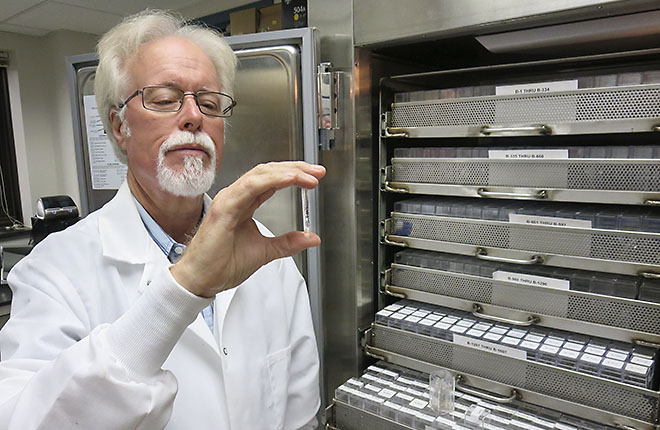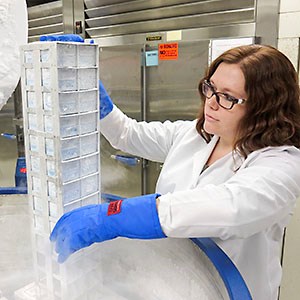ARS Culture Collection: A Valuable Resource
In a sometimes germophobic society, we spend countless hours and dollars disinfecting surfaces, washing our hands, and taking antibiotics to keep unwelcome bacteria, fungi, and viruses at bay. But at the Agricultural Research Service (ARS) Culture Collection—curated by scientists in Peoria, Illinois—microbes are not only welcomed but also pampered and celebrated for their astounding ability to make a rich cocktail of valuable chemicals and perform tasks of industrial, agricultural, cosmetic, and medical significance.
|
|
Established in 1940, the Culture Collection today houses approximately 100,000 strains of bacteria and fungi. All are kept in dormant states in a climate- and access-controlled room in the ARS Mycotoxin Prevention and Applied Microbiology Research Unit (MPM). The unit is part of ARS’s National Center for Agricultural Utilization Research (NCAUR) in Peoria. (See Bonus Content.) A small team of experts oversees the curation, characterization, and worldwide distribution of the strains for use in scientific research and other applications.
The collection, already the largest of its kind in the United States and abroad, continues to grow, as does demand for its microbial holdings and accompanying genomic databases. Over the past year, for example, MPM curators distributed 5,500 strains and added 500 new ones, including 200 deposited in the ARS Patent Culture Collection, a subgroup of microbes deposited in association with U.S. and international patent applications. (See Who Knows What Lurks? Microbial Collections Key to Unlocking New Discoveries, September 2008.)
MPM research leader Todd Ward estimates the strains they distribute each year represent a $1 million asset towards advancing the research and innovations of scientists who request the microbes. “Microbial isolates from the ARS Culture Collection have been used in more than 6,800 patents and 57,000 scientific publications,” Ward says.
Don Hahn, a Dow AgroSciences microbiologist specializing in natural crop protection products, values the strains as a wellspring of new compounds yet to be discovered or tested experimentally. In a recent submission to MPM’s “Tell Us Your Story” web page, Hahn writes, “each strain in the [Culture Collection] has potential for discovery in agriculture, my research, or for pharmaceutical or biotechnological applications.”
|
|
The collection’s holdings also figure prominently in the NCAUR’s own research pursuits, which include developing new, value-added products and biotechnological processes from agricultural commodities and their byproducts. Perhaps the best known example is the center’s role in scaling up production of the life-saving antibiotic penicillin during World War II, a medical advance jump-started by a moldy cantaloupe that was given to Peoria scientists. (Video: “Penicillin Was Pioneered in Peoria at USDA-ARS Research Lab.”)
The following are recent examples of new products, technologies, or processes that can trace their beginnings to the ARS Culture Collection:
• Sucromalt, a slow-digesting carbohydrate derived from the enzymes of Leuconostoc bacteria strains kept in the collection. Sucromalt became the original inspiration for a commercially developed low-glycemic syrup that helps regulate blood-sugar levels.
• “Green” surfactants, wetting agents with a long list of industrial uses, from detergents and cosmetics to paints and pesticide formulations. Annually, about 10 million tons of surfactants are produced, mainly from petroleum. However, certain Candida yeasts from the collection can make compounds called sophorolipids that could offer a “home-grown” alternative.
• Liamocin, a natural fungal oil that kills certain types of bacteria, including two Streptococcus species responsible for mastitis, an udder infection in cows that costs the U.S. dairy industry $2 billion annually. Large-scale production of the fungal oil could have potential use in veterinary, medical, industrial, and food applications.
• Mycotoxin detection and decontamination: ARS developed technology to identify mycotoxin-contaminated grain so it can be diverted from the food supply. The technology has been licensed to approximately 30 companies, helping ensure food safety, free and open trade markets for U.S. grain, and farmer profits.
• Genetic identification tests: ARS developed gene-sequence databases and molecular technologies for rapid and accurate identification of bacteria and fungi. The tests have been used worldwide to identify plant, animal, and human pathogens and even bioterrorism agents. The tests were used to assist the Federal Bureau of Investigation and its partners in their investigation of the 2001 anthrax attacks on members of the news media. (See “A Culture of Innovation,” April 2016.)
With growing demand for agriculture to meet the world’s food, fiber, feed, and fuel needs, the mighty microbes of the ARS Culture Collection are sure to play an increasingly prominent role in helping research and innovation keep pace.—Jan Suszkiw, ARS Office of Communications.
Key Facts
- The ARS Culture Collection contains about 100,000 strains of bacteria and fungi.
- The collection safeguards important microbial resources from around the world.
- ARS scientists manage, distribute, and conduct research on the strains.
- The collection has led to new products, improved food safety, medicines, and other benefits.
Full Story











